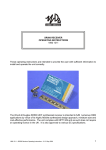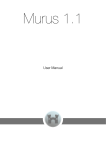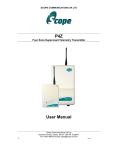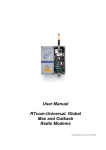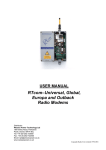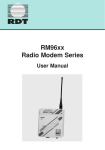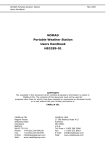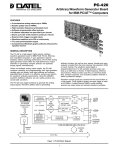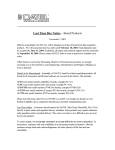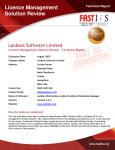Download Wood and Douglas 1892 Operating instructions
Transcript
SX450G TRANSCEIVER OPERATING INSTRUCTIONS 1892 1344 These operating instructions are intended to provide the user with sufficient information to install and operate the unit correctly. The Wood & Douglas SX450G is a high-performance synthesized UHF transceiver for use in radio telemetry applications. The transceiver provides a maximum power output of 500mW and is designed to meet European standards ETS 300 220, ETS300 086 and ETS300 339. The unit also complies with MPT1329 and as such does not require an operating licence in the UK when programmed to operate over the appropriate frequency range. Two versions are available, the SX450GA and the SX450GC. They differ only in connections, and are functionally identical. Programming software (SXn50) is supplied to set channel frequencies and select the operational channel, which can also be selected in hardware. 1892 1344 - SX450G Transceiver Operator Guide v1.7 / Nov 2007 1 Contents Part One The SX450G Radio Unit . . . . . . . . . . . . . . . . . . . . . . . . . . . . . . . . . . . . . . . . . . . . 3 DIMENSIONS AND FIXING . . . . . . . . . . . . . . . . . . . . . . . . . . . . . . . . . . . . . . . . . . 5 CONNECTIONS . . . . . . . . . . . . . . . . . . . . . . . . . . . . . . . . . . . . . . . . . . . . . . . . . . 7 POWER SUPPLY AND CURRENT CONSUMPTION . . . . . . . . . . . . . . . . . . . . . . 8 CHANNEL SELECTION DURING OPERATION . . . . . . . . . . . . . . . . . . . . . . . . . 10 RANGE INFORMATION . . . . . . . . . . . . . . . . . . . . . . . . . . . . . . . . . . . . . . . . . . . 12 Part Two Programming . . . . . . . . . . . . . . . . . . . . . . . . . . . . . . . . . . . . . . . . . . . . . . . . . . . CONNECTING THE UNIT TO A PC FOR PROGRAMMING . . . . . . . . . . . . . . . . PROGRAMMING THE UNIT . . . . . . . . . . . . . . . . . . . . . . . . . . . . . . . . . . . . . . . . DESCRIPTION OF USER INTERFACE . . . . . . . . . . . . . . . . . . . . . . . . . . . . . . . TECHNICAL SPECIFICATION . . . . . . . . . . . . . . . . . . . . . . . . . . . . . . . . . . . . . . 13 15 17 20 23 APPENDIX 1: TTL TO RS232 ADAPTOR . . . . . . . . . . . . . . . . . . . . . . . . . . . . . . . . . . . 25 APPENDIX 2: PCS WITHOUT RS232 SERIAL PORTS (COM PORTS) . . . . . . . . . . . . 27 APPENDIX 3: TERMINAL KEYSTROKES . . . . . . . . . . . . . . . . . . . . . . . . . . . . . . . . . . 28 2 1892 1344 - SX450G Transceiver Operator Guide v1.7 / Nov 2007 Part One The SX450G Radio Unit v Part Two, Programming, starts on page 13 1892 1344 - SX450G Transceiver Operator Guide v1.7 / Nov 2007 3 4 1892 1344 - SX450G Transceiver Operator Guide v1.7 / Nov 2007 DIMENSIONS AND FIXING The SX450G is intended to fit easily and with minimum space requirements into the user's own equipment housing. Figure 1 SX450G fixing detail Figure 2 - SX450GA connectors Figure 3 - SX450GC connector SX450GA mating connectors: 12W mating connector is MOLEX 51021-1200 with 50079 crimps. 8W mating connector is MOLEX 51021-0800 with 50079 crimps. One each of these connectors, mounted onto a 200mm flying lead, is supplied with each unit. 1892 1344 - SX450G Transceiver Operator Guide v1.7 / Nov 2007 5 The four corner tabs of the enclosure can be folded out to provide alternative mounting of the unit, with fixing centres of 93.00 x 47.5mm using four M2 screws. Figure 4 - Alternative mounting dimensions 6 1892 1344 - SX450G Transceiver Operator Guide v1.7 / Nov 2007 CONNECTIONS The radio antenna connects via an MMCX 50O socket. All other connections to the SX450GA transceiver are made via a 12-way connector PL1 and an 8-way connector PL2. These are single-in-line plugs which mate with the freeissued connectors with flying leads. All other connections to the SX450GC transceiver are made via a 21-way SIL PCB connector, PL1. SX450GA SX450GC NAME PL1-1 PL1-1 0V PL1-2 PL1-2 PL1-3 FUNCTION REMARKS 0 volts common ground STBY standby input LOW (<+0.6V) = transceiver enabled HIGH (>+2.0V) = standby mode (internal pull-up, 40K to +4V max) PL1-3 HI/LO TX RF power select input >+2.0V = high power, <+0.8V = low power (internal pull-down, 10K to 0V) PL1-4 PL1-4 +Vin positive supply input +5.5 to +9.0 V input (-ve earth) PL1-5 PL1-5 TXE transmit enable input HIGH (>+2.0V) = receiver enabled LOW (<+0.8V) = transmitter enabled (internal pull-up, 100K to +5V) PL1-6 PL1-6 TXD/MS TXD - serial data input MS - PL1-7 PL1-7 CS0/DT CS0 - DT - PL1-8 PL1-8 CS1/CK CS1 CK - PL1-9 PL1-9 CS2/EN CS2 EN - Serial data input = single 8-bit RS232 format control word, ie logic 1 = -V, logic 0 = +V (Maximum voltage level is +12V; inverted TTL acceptable). mode select, i.e. channel selection by serial or parallel data input Mode selected depends on the logic state at any time: HIGH > 1ms (>+2.0V) = parallel data input. Defaults to this state if left open circuit (internal pull-up, 50K to +3V). LOW (<+0.8V) = serial data input; connection to an RS232 output will automatically keep it at this state. channel select input (LSB) synthesizer serial data input* Channel select inputs use inverted 5V logic levels; HIGH (>+2.0V) = logic 0, LOW (<+0.8V) = logic 1 CS0 to CS5 are used for channel selection by 6bit parallel data (Internal pull-ups 100K to +5V) channel select input synthesizer programme clock * (* DT/CK/EN inputs are used for direct control of the synthesizer, this is a separate version of the SX450.) channel select input synthesizer enable strobe input* PL1-10 PL1-10 CS3 channel select input PL1-11 PL1-11 CS4 channel select input 1892 1344 - SX450G Transceiver Operator Guide v1.7 / Nov 2007 7 PL1-12 PL1-12 CS5 PL1-13 - channel select input (MSB) not connected RF DET TX RF present flag output - PL2-1 PL1-14 PL2-2 PL1-15 PL2-3 PL1-16 SQO squelch flag output NPN open collector via 470O; ON = no signal, OFF = signal present. (NOTE: OFF when transceiver in standby mode) PL2-4 PL1-17 OOL out-of-lock output NPN open collector via 470O; ON = out of lock (NOTE: OFF when transceiver in standby mode) PL2-5 PL1-18 DMOD digital modulation input ** +3V to +12V square wave, DC-coupled ** DMOD and AMOD may not be used simultaneously. Leave unused input unconnected. PL2-6 PL1-19 AMOD analogue modulation input ** 750mV p-p., AC-coupled (pre-settable 200mV to 3V p-p.) ** DMOD and AMOD may not be used simultaneously. Leave unused input unconnected. PL2-7 PL1-20 RSSI 'S' meter output 0V to +3V output, rising with received signal level (typ. 50dB range) PL2-8 PL1-21 SQOR squelch override input HIGH (>+2.0V) enables AF O/P regardless of squelch state (RX only) LOW (+0.8V or o/c) = normal operation (internal pull-down, 70K to 0V) AF O/P receiver audio output HIGH (+5V, internal 10K pull-up) = TX RF present LOW (0V) = no TX RF NOTE: only available when high TX RF power is selected 600mV p.p. nom. into 10K; AC-coupled; Rout = 2K3. POWER SUPPLY AND CURRENT CONSUMPTION The SX450G requires a power supply of 5V to 15V DC (7.2V DC nominal). Because the circuitry includes switched-mode power supplies, the current consumed varies inversely with input voltage, and the external power supply must be capable of supplying the corresponding current shown in the table below. Input 5V 7.2V 12V RX 45mA 30mA 25mA TX 5mW 45mA 30mA 25mA TX 500mW 400mA 250mA 200mA State Table 1 - Maximum supply current for various input voltages Note: Connection to a vehicle supply without proper external transient suppression can cause the internal configuration data to be corrupted. 8 1892 1344 - SX450G Transceiver Operator Guide v1.7 / Nov 2007 OVERVIEW OF FREQUENCIES AND PROGRAMMING Each radio is built to order to cover a band (the switching bandwidth) of 20MHz within the range 400 - 470 MHz. Each radio is also manufactured to work with a particular channel width of 12.5kHz, 20kHz or 25kHz. These are fixed parameters, and cannot be changed by the user. Within the switching bandwidth, the unit can transmit and receive on any frequency (provided it is a whole multiple of the comparison frequency), and up to 256 frequencies can be stored as numbered channels 0 to 255. There can also be an offset between transmit and receive frequencies. You can program this offset, but both transmit and receive frequencies must remain within the switching bandwidth for all channels. For example: Switching bandwidth = 450MHz to 470MHz (fixed at manufacture) Rx offset = +5MHz (programmed by user) Therefore, maximum Tx frequency allowable = 470MHz - 5MHz = 465MHz. During use, an operational channel can be selected at any time either using logic lines or a serial data input. Logic lines can only select channels 0-63, serial commands can select any channel. Before the unit leaves the factory, each of 256 channels is allocated to a frequency, but you can reprogram them if you wish. You can program the unit in one of two modes: v 256-channel mode: All 256 channels 0-255 can be programmed, but as a block by entering a starting frequency and a step size, so that they contain uniformly spaced frequencies. A single Rx offset applies to all channels. v 80-channel mode: Each of channels 0-79 can be individually programmed with any frequency, but the remaining channels 80-255 are not available for use. Individual Rx offsets may be applied to channels. One channel is then nominated as the operational channel. To program a unit, you need to read the existing data from the it, edit the data using a special program supplied by Wood & Douglas (SXn50.EXE), which runs on a PC under Windows, then write the data back to the unit. This software provides facilities, such as a list of valid frequencies, and the ability to copy one channel’s details to a number of others, to make the job easier. Programming is described in Part Two of this manual, starting on page 13. 1892 1344 - SX450G Transceiver Operator Guide v1.7 / Nov 2007 9 CHANNEL SELECTION DURING OPERATION There are three ways to select a channel during operation: v v v In hardware, using six logic lines to select channels 0-63 Using the SXn50.EXE software and a serial connection from a PC to the unit By sending a short serial data message to the unit from your own equipment. Parallel Channel Selection v Whenever PL1 pin 6 , Mode Select, is logic high (>2.0V) or open-circuit, the channel is determined by the six channel select inputs - that is, parallel channel selection is in operation. v Only channels 0 - 63 are available in this mode The six channel select inputs are an inverse binary representation of the channel number, that is, switch ON = input LOW = logic 1. If no connections are made, the unit therefore defaults to channel 0. Figure 5 - Parallel channel selection Changes are implemented immediately. The logic levels are : 10 LOW < 0.8V HIGH > 2V or floating 1892 1344 - SX450G Transceiver Operator Guide v1.7 / Nov 2007 Serial Channel Selection v PL1 pin 6 must be logic low (<0.8V) to specify serial channel selection. This is automatically the case when connected to an idle RS232 data output. v Channels 0 - 255 are available in this mode The channel can be changed by sending a serial channel number as a single RS232 byte on PL1 pin 6. The SXn50.exe software has the ability to do this, or you can use your own equipment. A simple adaptor such as the one in Figure 6 can be used to connect a PC to the unit. (The programming adaptor of Figure 10, which can be purchased from Wood & Douglas, product code 01106 1503 A, is also suitable.) If you use a computer which does not have an RS232 serial port, then a USB-to-serial adaptor is also needed, described in Appendix 2 on page 27. The SX450G also requires a power supply capable of sourcing approximately 60mA. Figure 6 - Serial channel change adaptor The protocol is: 9600 baud, RS232 levels, 1 start bit - 8 bit data - no parity - 1 stop bit Single-byte, channel number in binary, LSB first (decimal 0 to 255) Idle state for at least 40ms before and after byte. As soon as the message is recognised as a valid RS232 byte, the channel is changed. No confirmation is required. 1892 1344 - SX450G Transceiver Operator Guide v1.7 / Nov 2007 11 When in this mode, the unit operates on the channel most recently selected in serial mode. This setting is remembered during unit power off and any period of parallel channel selection. One way to send such a byte is to use a terminal such as a VT100 or emulator. Appendix 3 on page 28 shows the keystrokes necessary to generate the appropriate binary codes for channels 0 to 127. RANGE INFORMATION The following table gives an indication of the typical ranges to be expected between a transmitter and receiver that have simple end-fed dipole antennas. The following assumptions have been made in the calculations: Line-of-sight between antennas 0dB gain for the transmitter and receiver antennas 0dB loss for connectors and cables between the antenna and the radio connector 20dB fade and environmental margin -100dBm received signal strength, allowing for digital and analogue signals Range versus TX power 12 Frequency (MHz) Power (mW) Power (dBm) Range (km) 458.5 1mW 0 0.5 458.5 10mW 10 1.7 458.5 100mW 20 5.3 458.5 500mW 27 11.9 1892 1344 - SX450G Transceiver Operator Guide v1.7 / Nov 2007 Part Two Programming 1892 1344 - SX450G Transceiver Operator Guide v1.7 / Nov 2007 13 14 1892 1344 - SX450G Transceiver Operator Guide v1.7 / Nov 2007 CONNECTING THE UNIT TO A PC FOR PROGRAMMING In order to program the unit, the unit and a PC (IBM-compatible personal computer) must communicate via an asynchronous RS232 serial link. The adaptors shown in the Appendix 1 on page 25 provide this link. A simple adaptor for the SX450GA like that shown in Figure 10 can be purchased from Wood & Douglas, product code 01106 1503 A. If your computer does not have an RS232 serial port, then a USB-to-serial adaptor is required, described in Appendix 2 on page 27. The SX450G and adaptor also require a power supply capable of sourcing approximately 60mA. 1892 1344 - SX450G Transceiver Operator Guide v1.7 / Nov 2007 15 OBTAINING AND RUNNING THE PROGRAMMING SOFTWARE 1. Download the latest version of the programming software SXn50.exe from the Wood & Douglas site on the internet. The URL (address) is: www.woodanddouglas.co.uk (In case of difficulty, contact Sales at Wood & Douglas, contact details on the last page of this manual.) 2. Open the Zip file and run setup.exe, which will install the software for you. 3. Run the SXn50.EXE program. It will run in a normal window with both mouse and keyboard support. At this stage, the main window is displayed as shown in Figure 7. Figure 7 - Programming screen The screen shows the default settings which are displayed whenever the SXn50 software is run. The menu bar at the top lists a number of headings, under which there are usually additional menu items, representing actions. Below this, there is the Frequency Table. The leftmost column lists the channel numbers, and beside channels 0 to 63 are listed the inverted binary equivalents used for parallel selection. The next column, TX Frequency, is used to set and display channel frequencies. Use the Port Setup > Com Port > COM1 etc. menu selection to select the port to which your adaptor is connected. 16 1892 1344 - SX450G Transceiver Operator Guide v1.7 / Nov 2007 PROGRAMMING THE UNIT Three steps are necessary: v v v Upload (read) values from the unit Edit the values Download (write) values to the unit Reading Current Unit Settings First, you must read into the computer what is in the unit’s memory at present. To do this, press F5 or select Link > Read from the Unit > Upload All from SX450G. The data replaces the defaults on the screen and fills in the unit details. v The program insists that you do this before allowing you to reprogram the unit to make it less likely that inappropriate values be entered. v However, once you have uploaded during a session, you may edit and download the data to as many units as you wish. Selecting Table Type The SX450G can hold either a table of 80 individually-chosen Tx frequencies and Rx offsets, or a table of 256 equally-spaced Tx frequencies all with the same Rx offset. To select the table type, select Parameters > Number of Channels > 80 or 256. Programming 256 Channels as a Block It is necessary to specify the starting frequency (the lowest, corresponding to channel 0), a spacing or step value, and an Rx offset. The spacing is expressed in multiples of the Comparison Frequency (including 0, which makes all frequencies the same). Double-click the Tx Frequency value for channel 0 in the main frequency table, which brings up this dialog: Figure 8 - Frequency Programming Dialog 1892 1344 - SX450G Transceiver Operator Guide v1.7 / Nov 2007 17 v The list displays all valid values for the starting frequency, that is, frequencies within the switching bandwidth which are multiples of the Comparison Frequency. Select a Table Start frequency from the list and a Table Step and click OK. The dialog is removed and the main table shows the channel frequencies. To set the Rx Offset for the whole table, select Parameters > Rx Offset and pick from the list of possible values. Programming Up To 80 Channels Individually Double-click the Tx Frequency value for the channel to program in the main frequency table, which brings up this dialog: Figure 9 - Frequency Programming Dialog v Valid values for the starting frequency are frequencies within the switching bandwidth which are multiples of the Comparison Frequency. Select a Table Start frequency, ignoring the other parameters, and click OK. The dialog is removed and the main table shows the channel with its new frequency. To set the Rx Offset for the channel, select Parameters > Rx Offset and pick from the list of possible values. It is also possible to program a range of channels automatically in a similar way to the 256 channel block. In the Frequency Programming Dialog, select the range of channels required (the From and To drop-downs), a Table Start and Channel Step, and click on OK. The dialog is removed and the main table shows the channels with their new frequencies. It is not possible to select Rx Offset for a range of channels; this must be done individually. Setting Operational Channel The unit must be told which of the 80 or 256 channel settings to use when it is powered up. If PL1 pin 6 is open-circuit or logic high (>2.0V) for more than 1ms at power-up, then 18 1892 1344 - SX450G Transceiver Operator Guide v1.7 / Nov 2007 this is determined by hardware logic lines. Otherwise it depends on the most recent serial command received, which is retained during power-down and during parallel operation. To set the operational channel, double-click on the channel number in the frequency table. The row is highlighted to indicate that this is the operational channel. Downloading New Settings to Unit As yet, the settings have only been edited in the program. To download them to the unit, press F6 or select Link > Write to the Unit > Download All to SX450G v This is only permitted if the Read from Unit command was previously used to upload settings at some point during the session. v If you did not do this, save the configuration to disk, read the unit, and then retrieve the configuration again. See below. Completing Programming This completes programming and the unit may be disconnected. It is not necessary to switch off power or stop the program first. Programming Further Units Further units may be programmed by disconnecting one unit and connecting the next, which may be done without switching the power off. Proceed as above, downloading the configuration when all the channel parameters are correct. Saving and Retrieving Configurations It is possible to save and retrieve configurations on disk for later use. To save a new configuration, select File > Save Parameters As. To save a previously saved configuration, select File > Save Parameters. To retrieve a configuration, overwriting any existing configuration on the screen, select File > Load Parameters. v This feature is also useful if you find that you cannot program a unit because you omitted to read it first. Save your edited configuration, read the unit, then retrieve the configuration. 1892 1344 - SX450G Transceiver Operator Guide v1.7 / Nov 2007 19 DESCRIPTION OF USER INTERFACE Top Level Menu Bar (Outer Window) File Load Parameters Load a pre-stored set of parameters in a *.WXP file from a standard File Open dialog. Save Parameters Save the current set of parameters, overwriting the previous ones. Save Parameters As Save the current set of parameters under a new name. A default name is given which you can change, and you can navigate to the directory of your choice. Saving Options Controls the format in which information is saved. Provided you are programming an SX450G, you should save in the default Format 2, allowing 80 channels with IF offsets. Format 1 is only used with legacy SX450 modules. Save Report File Save the current report. A default name is given which you can change, and you can navigate to the directory of your choice. Print Print the current set of parameters; only available when Report File window is open. The currently selected Windows default printer will be used. Update Firmware Replace the firmware in a unit with a binary file which you can choose from a standard File Open dialog. Caution: Exit Program This can render a unit unusable and require repairs by Wood & Douglas if done incorrectly. Exit the program. Parameters Reference Osc Fixed in hardware, display only. Comparison Frequency Fixed in hardware, display only. Channel Step Size Multiple of the Comparison Frequency Number of Channels 80 (individually programmed) or 256 (programmed as a sequence) Select Rx Offset A number of choices, multiples of the Comparison Frequency, are offered. 20 1892 1344 - SX450G Transceiver Operator Guide v1.7 / Nov 2007 Link Read from Unit Reads data from the unit into the program, which is then displayed on the screen. Until this command has been issued, no data can be downloaded to the unit. Write to Unit Downloads data from the program to the unit. This command can only be issued after a Read from Unit command has been issued during the current session. Send e-mail Causes your default email application to create a new blank email addressed to Wood & Douglas technical support with the subject “SNx50". Port Setup Com Port Allows you to select one of the COM (serial) ports on your machine to communicate with the SX450G. View Main Menu Turns on and off display of the Main Menu window. Internal EEPROM This displays the contents of the unit’s EEPROM in a separate window. The data displayed is for the functions and channels displayed on the main screen at that time. Data can be handmodified by highlighting the data and over-writing it. Note that the type of data in each field is displayed at the bottom of the window. Caution: This should only be carried out with full knowledge of the internal working of the SX450G. It can render a unit unusable and require repairs by Wood & Douglas if done incorrectly. While this window is displayed, no access is available to the main window. The window must be cleared down by clearing the check mark against it in the View menu. Report File Displays a report on the current setup shown in the main menu which can be printed if you wish. Help About Displays information about Wood & Douglas, including website and contact details. Check for GUI Update Checks the Wood & Douglas website for updates and offers to update your GUI if appropriate. 1892 1344 - SX450G Transceiver Operator Guide v1.7 / Nov 2007 21 Main Menu - Frequency Table (Inner Window) Channel Table The Channel Table shows the following parameters for each of the 80 or 256 channels, as appropriate: Channel No Parallel (logic lines) code required to select this channel, where 1 represents a connection to 0v, closed contact to 0V or logic low. Tx Frequency The transmit frequency. Rx Frequency The receive frequency (which may be different if an Rx offset has been selected). Rx Offset The amount by which the Rx frequency is higher than the Tx frequency. Unit Information This box is display only and cannot be edited. File Name The name of the firmware running in the unit. File Version The version of firmware running in the unit. File Date The date of the firmware running in the unit S/N The serial number of the unit. Number of Channels How many channels are programmed and may be selected during operation. Maximum Frequency The software assumes a 5MHz switching bandwidth to calculate the Maximum Frequency from the Minimum Frequency and uses this to calculate the frequencies in the drop-down list displayed when selecting channel frequencies. Minimum Frequency The minimum frequency refers to the transmit band, and is used by the software as a base-line for all other frequency information. The software will not allow a channel to be set to a frequency below this minimum (or, in the case of a received channel, this frequency plus the receive offset). This frequency is stored in the non-volatile EEPROM in the unit. 22 1892 1344 - SX450G Transceiver Operator Guide v1.7 / Nov 2007 TECHNICAL SPECIFICATION General Frequency range A band within the range 400-490MHz, to order Switching bandwidth 15 or 20MHz depending on band ordered. Frequency stability +2.5ppm over operating temperature Channel switching delay 100ms maximum (over 20MHz switching bandwidth) Channel programming Table of 256 equally-spaced frequencies with common RxTx offset, or table of 80 individually-programmed frequencies and Rx-Tx offsets. Channel selection 64 channels maximum using 6-bit parallel logic line input. 256 channels maximum using serial RS232 data word. Serial/parallel selection switchable in real time. Channel spacing 12.5kHz/20kHz/25kHz available Modulation type F1D/F2D/F3D Spurious emissions (conducted & radiated) In accordance with ETSI/CEPT Supply voltage 5 to 15V DC negative earth Supply current at 7.2V 30mA typical (receive), 250mA typical for 500mW output (transmit) Interface connections 21 pin SIL PCB connection (SX450GC) 1 x 8 + 1 x 12 way 1.27mm pitch Molex right angle plug with mating connector + 200mm lead (SX450GA) RF connection PC mounted MMCX socket (200mm RG178 lead supplied). Operating temperature -25%C to +55%C Storage temperature -30%C to +70%C Size overall 85 x 55 x 12.7mm Weight 70g Type approvals ETS300 220, ETS300 339 (EMC), ETS300 086, UK MPT1329 1892 1344 - SX450G Transceiver Operator Guide v1.7 / Nov 2007 23 Transmitter RF output power into 50O 500mW (HI) (+0/-1.5dB) 5mW (LO) TX/RX switching time <25ms Modulation input analogue digital 750mV p-p, AC-coupled +3 to +12V square wave DC-coupled Frequency response 9Hz to 3kHz at -3dB (analogue input) (optional extended response to 6kHz for 9600 baud GMSK) Frequency deviation 25kHz channel spacing 20kHz channel spacing 12.5kHz channel spacing +3.0kHz nominal (+4.0kHz max) +2.3kHz nominal (+3.0kHz max) +1.5kHz nominal (+2.0kHz max) Adjacent channel power <200nW (-37dBm) Facilities RF detect output (+5V = TX on) (HI power only) Receiver Sensitivity <-115dBm for 12dB SINAD (Measured with flat audio response) <-107dBm for 20dB SINAD (Measured with flat audio response) Image rejection >70dB Intermodulation rejection >65dB Blocking >84dB Spurious rejection >70dB Intermediate frequencies 45MHz and 455kHz Adjacent channel rejection 12.5kHz channel spacing 20/25kHz channel spacing >60dB >70dB Recovered audio level 600mV p-p (+20%) into 10K Squelch type Noise operated Squelch output NPN open collector via 470O ON = no signal, OFF = signal present Facilities RSSI output (0 to +3V nominal from 2K2 source) Squelch override input STBY input Standby current 150uA typ for HI/LO input = 0V 24 1892 1344 - SX450G Transceiver Operator Guide v1.7 / Nov 2007 APPENDIX 1: TTL TO RS232 ADAPTOR These adaptors are used to connect a PC to the SX450G when programming a unit. Many PCs do not require true RS232, and will work with the simple adaptor of Figure 10. The transistor used must have a gain of at least 30, and the power supply must be 12V. Figure 10 - Simple programming adaptor Figure 11 shows the circuit of an adaptor providing true RS232. Figure 11 - Programming adaptor (True RS232) 1892 1344 - SX450G Transceiver Operator Guide v1.7 / Nov 2007 25 A suitable inverting TTL to RS232 buffer circuit using the industry-standard MAX232 part is shown in Figure 12. Figure 12 - Suggested RS232 buffer circuit The MAX232 is obtainable from many component suppliers, e.g. RS Components stock no. 655-290. v 26 Note that the MAX232 has an absolute maximum supply voltage of 6V, and therefore the SX450G and the adaptor should be run from a 5V DC supply. 1892 1344 - SX450G Transceiver Operator Guide v1.7 / Nov 2007 APPENDIX 2: PCS WITHOUT RS232 SERIAL PORTS (COM PORTS) Some laptops and PCs are no longer supplied with RS232 serial ports; in this case, a USB-to-RS232 adaptor can be used to connect the PC running SXn50.EXE to the SX450G. Wood & Douglas have tried a range of adaptors and recommend the EasySync US232B/LC, which has been tested with Windows 2000 and Windows XP. v 1. Further information and a downloadable manual can be found at www.easysync.co.uk/usbrs232_single.html. Installing the Adaptor The adaptor is supplied with printed instructions and an installation disc. Before plugging the adaptor into the host computer’s USB port, insert the installation disc into the PC’s CD-ROM drive, then follow the on-screen instructions for your version of Windows. When the installation is complete, proceed as follows to find its COM port number: 1. Open the Control Panel (Start, Settings, Control Panel) and open the System control. 2. Select Hardware, Device Manager and expand the Ports (COM & LPT) folder. 3. Find the entry labelled “USB Serial Port (COM n)” and note the number n. 4. Close the Device Manager, System and Control Panel windows. If there is no USB Serial Port (COM n) entry, remove and re-insert the adaptor in the USB port. If this fails to clear the problem, uninstall the adaptor and repeat this section. 2. Connecting the Command Centre PC and the SX450G With the USB Serial Port Adaptor plugged into the PC USB port, connect the adaptor cable (Figure 9) from the SX450G serial port to the USB adaptor serial port and the power supply, and turn the power supply on. 3. Configuring the GUI Run the GUI, select Port Setup from the menu bar and click Com Port. From the list of ports, select the number of the COM port found in the previous procedure. When the GUI sends data to the unit, the red LED on the adaptor flashes. When the unit replies, the green LED on the adaptor flashes. 1892 1344 - SX450G Transceiver Operator Guide v1.7 / Nov 2007 27 APPENDIX 3: TERMINAL KEYSTROKES These keystrokes generate a serial byte output from a standard (e.g. VT100) terminal which can be used to select channels 0 to 127 in serial mode. For example, to select channel 36, key Shift+4 (dollars), which generates the byte 00100100, decimal 36. Other keystrokes may generate codes 128 to 255, depending on the terminal. No 0 1 2 3 4 5 6 7 8 9 10 11 12 13 14 15 16 17 18 19 20 21 22 23 24 25 26 27 28 29 30 31 Keystroke Ctrl @ Ctrl A Ctrl B Ctrl C Ctrl D Ctrl E Ctrl F Ctrl G Ctrl H Ctrl I Ctrl J Ctrl K Ctrl L Ctrl M Ctrl N Ctrl O Ctrl P Ctrl Q Ctrl R Ctrl S Ctrl T Ctrl U Ctrl V Ctrl W Ctrl X Ctrl Y Ctrl Z Ctrl [ Ctrl \ Ctrl ] Ctrl ^ Ctrl _ 32 33 34 35 36 37 38 39 40 41 42 43 44 45 46 47 48 49 50 51 52 53 54 55 56 57 58 59 60 61 62 63 64 <SPACE> Shift 1 Shift ‘ Shift 3 Shift 4 Shift 5 Shift 7 ‘ Shift 9 Shift 0 Shift 8 Shift = , . / 0 1 2 3 4 5 6 7 8 9 Shift ; ; Shift , 0 Shift . Shift / Shift 2 Wood & Douglas Ltd, Lattice House Baughurst, Tadley, Hants, RG26 5LP Tel:+44 (0)118 981 1444 Fax: +44 (0)118 981 1567 email: [email protected] website: www.woodanddouglas.co.uk 28 65 66 67 68 69 70 71 72 73 74 75 76 77 78 79 80 81 82 83 84 85 86 87 88 89 90 91 92 93 94 95 96 97 Shift A Shift B Shift C Shift D Shift E Shift F Shift G Shift H Shift I Shift J Shift K Shift L Shift M Shift N Shift O Shift P Shift Q Shift R Shift S Shift T Shift U Shift V Shift W Shift X Shift Y Shift Z [ \ ] Shift 6 Shift ` A 98 99 100 101 102 103 104 105 106 107 108 109 110 111 112 113 114 115 116 117 118 119 120 121 122 123 124 125 126 127 B C D E F G H I J K L M N O P Q R S T U V W X Y Z Shift [ Shift \ Shift ] Shift ` Del © Wood & Douglas Ltd 2007 1892 1344 - SX450G Transceiver Operator Guide v1.7 / Nov 2007






























